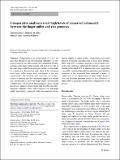Comparative analyses reveal high levels of conserved colinearity between the finger millet and rice genomes
Publication Date
2007-08-01Author
Mathews M Dida, Mike D Gale, Katrien M Devos
Metadata
Show full item recordAbstract/
Finger millet is an allotetraploid (2n = 4x = 36) grass that belongs to the Chloridoideae subfamily. A comparative analysis has been carried out to determine the relationship of the finger millet genome with that of rice. Six of the nine finger millet homoeologous groups corresponded to a single rice chromosome each. Each of the remaining three finger millet groups were orthologous to two rice chromosomes, and in all the three cases one rice chromosome was inserted into the centromeric region of a second rice chromosome to give the finger millet chromosomal configuration. All observed rearrangements were, among the grasses, unique to finger millet and, possibly, the Chloridoideae subfamily. Gene orders between rice and finger millet were highly conserved, with rearrangements being limited largely to single marker transpositions and small putative inversions encompassing at most three markers. Only some 10% of markers mapped to non-syntenic positions in rice and finger millet and the majority of these were located in the distal 14% of chromosome arms, supporting a possible correlation between recombination and sequence evolution as has previously been observed in wheat. A comparison of the organization of finger millet, Panicoideae and Pooideae genomes relative to rice allowed us to infer putative ancestral chromosome configurations in the grasses.

